Early Childhood Education: Policy, Risk, and Support in UAE Context
VerifiedAdded on 2022/09/14
|9
|2463
|18
Report
AI Summary
This report addresses key aspects of early childhood education in the United Arab Emirates, focusing on risk management, policy development, and support systems. It explores strategies for mitigating risks like workplace hazards and bullying, emphasizing the importance of control measures such as hazard assessment, safety precautions, and first aid. The report details the development of policies and practices, including reviews of existing policies, feedback from stakeholders, and gap analysis to ensure compliance with standards. It recommends changes to policies to incorporate parental involvement and child-centered approaches. The report also discusses relevant legislation and the importance of collaboration with various organizations, including DBS checks and data protection. Additionally, it highlights the significance of mentoring, coaching, and providing support for those working with peers, including training, motivation, and conflict management strategies. The report concludes with a discussion of the benefits of mentoring programs for professional development. The report has been submitted by a student and is available on Desklib.
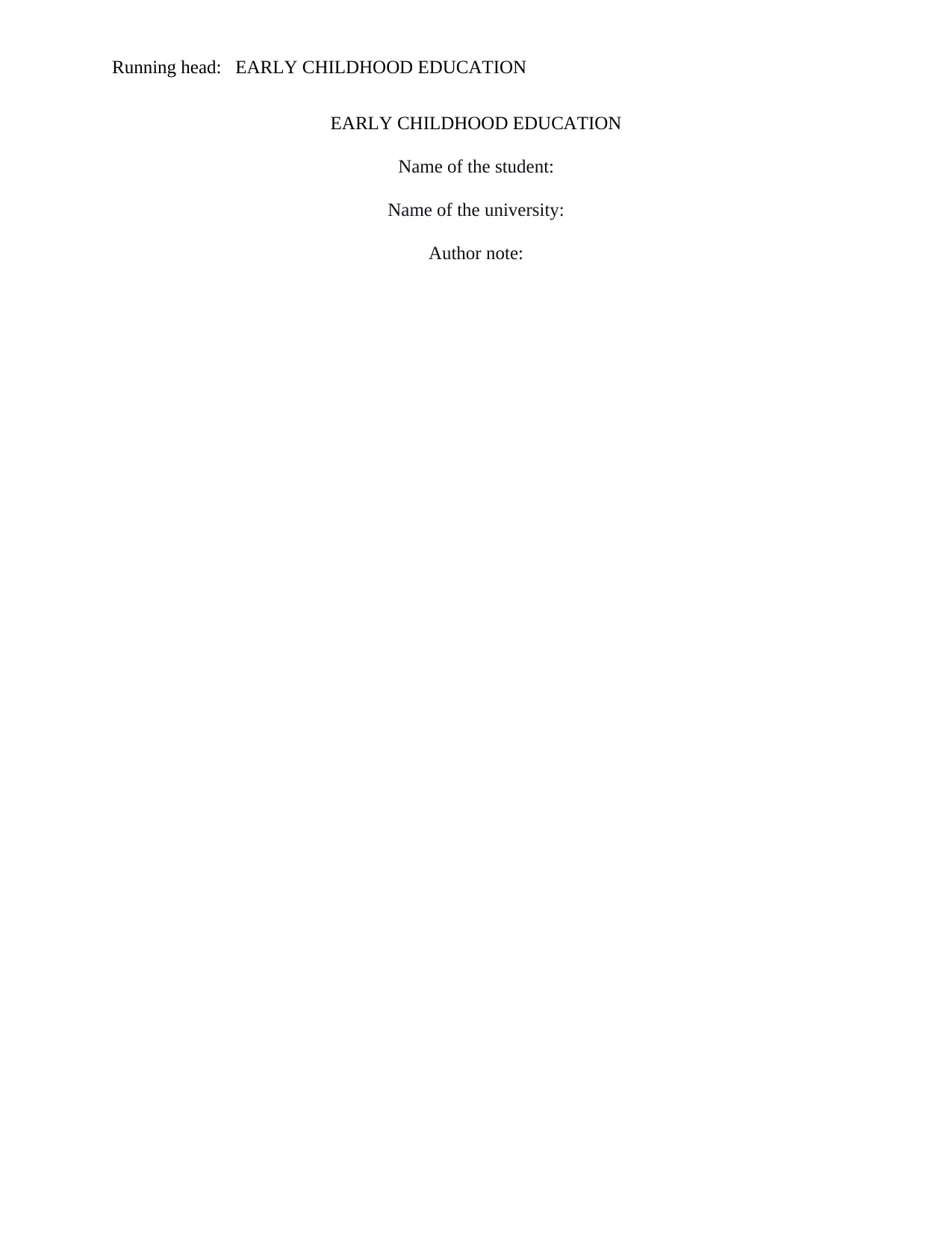
Running head: EARLY CHILDHOOD EDUCATION
EARLY CHILDHOOD EDUCATION
Name of the student:
Name of the university:
Author note:
EARLY CHILDHOOD EDUCATION
Name of the student:
Name of the university:
Author note:
Paraphrase This Document
Need a fresh take? Get an instant paraphrase of this document with our AI Paraphraser
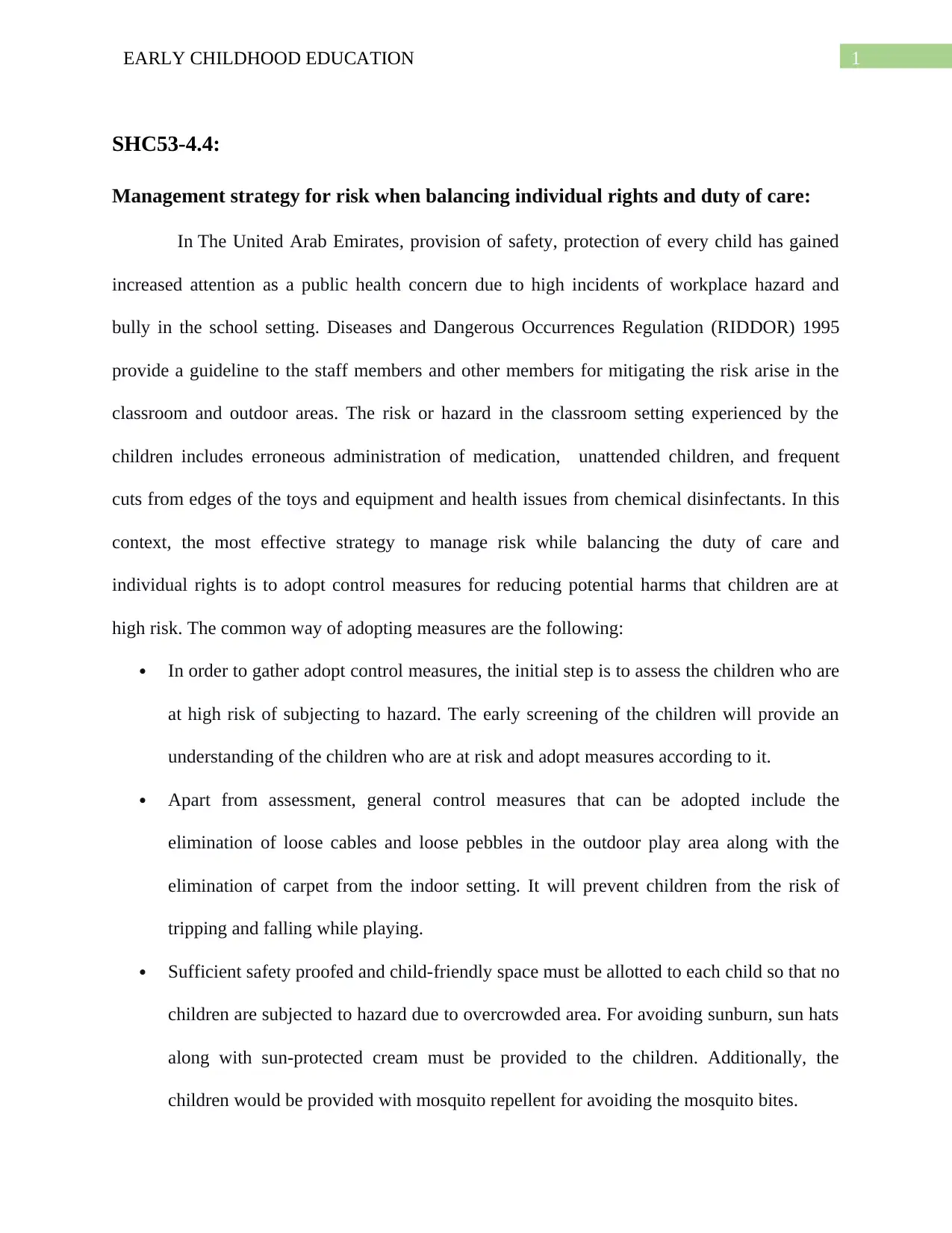
1EARLY CHILDHOOD EDUCATION
SHC53-4.4:
Management strategy for risk when balancing individual rights and duty of care:
In The United Arab Emirates, provision of safety, protection of every child has gained
increased attention as a public health concern due to high incidents of workplace hazard and
bully in the school setting. Diseases and Dangerous Occurrences Regulation (RIDDOR) 1995
provide a guideline to the staff members and other members for mitigating the risk arise in the
classroom and outdoor areas. The risk or hazard in the classroom setting experienced by the
children includes erroneous administration of medication, unattended children, and frequent
cuts from edges of the toys and equipment and health issues from chemical disinfectants. In this
context, the most effective strategy to manage risk while balancing the duty of care and
individual rights is to adopt control measures for reducing potential harms that children are at
high risk. The common way of adopting measures are the following:
In order to gather adopt control measures, the initial step is to assess the children who are
at high risk of subjecting to hazard. The early screening of the children will provide an
understanding of the children who are at risk and adopt measures according to it.
Apart from assessment, general control measures that can be adopted include the
elimination of loose cables and loose pebbles in the outdoor play area along with the
elimination of carpet from the indoor setting. It will prevent children from the risk of
tripping and falling while playing.
Sufficient safety proofed and child-friendly space must be allotted to each child so that no
children are subjected to hazard due to overcrowded area. For avoiding sunburn, sun hats
along with sun-protected cream must be provided to the children. Additionally, the
children would be provided with mosquito repellent for avoiding the mosquito bites.
SHC53-4.4:
Management strategy for risk when balancing individual rights and duty of care:
In The United Arab Emirates, provision of safety, protection of every child has gained
increased attention as a public health concern due to high incidents of workplace hazard and
bully in the school setting. Diseases and Dangerous Occurrences Regulation (RIDDOR) 1995
provide a guideline to the staff members and other members for mitigating the risk arise in the
classroom and outdoor areas. The risk or hazard in the classroom setting experienced by the
children includes erroneous administration of medication, unattended children, and frequent
cuts from edges of the toys and equipment and health issues from chemical disinfectants. In this
context, the most effective strategy to manage risk while balancing the duty of care and
individual rights is to adopt control measures for reducing potential harms that children are at
high risk. The common way of adopting measures are the following:
In order to gather adopt control measures, the initial step is to assess the children who are
at high risk of subjecting to hazard. The early screening of the children will provide an
understanding of the children who are at risk and adopt measures according to it.
Apart from assessment, general control measures that can be adopted include the
elimination of loose cables and loose pebbles in the outdoor play area along with the
elimination of carpet from the indoor setting. It will prevent children from the risk of
tripping and falling while playing.
Sufficient safety proofed and child-friendly space must be allotted to each child so that no
children are subjected to hazard due to overcrowded area. For avoiding sunburn, sun hats
along with sun-protected cream must be provided to the children. Additionally, the
children would be provided with mosquito repellent for avoiding the mosquito bites.
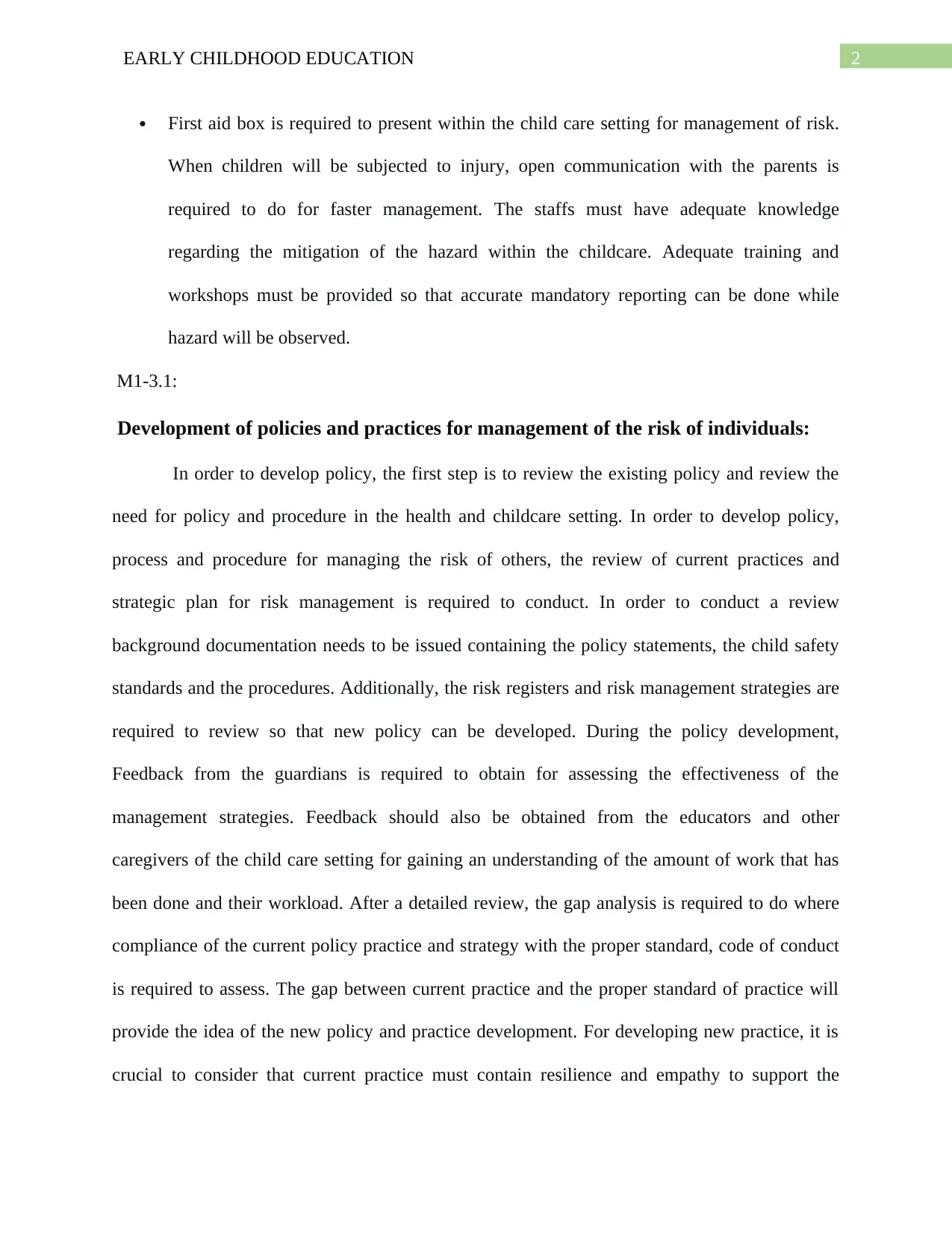
2EARLY CHILDHOOD EDUCATION
First aid box is required to present within the child care setting for management of risk.
When children will be subjected to injury, open communication with the parents is
required to do for faster management. The staffs must have adequate knowledge
regarding the mitigation of the hazard within the childcare. Adequate training and
workshops must be provided so that accurate mandatory reporting can be done while
hazard will be observed.
M1-3.1:
Development of policies and practices for management of the risk of individuals:
In order to develop policy, the first step is to review the existing policy and review the
need for policy and procedure in the health and childcare setting. In order to develop policy,
process and procedure for managing the risk of others, the review of current practices and
strategic plan for risk management is required to conduct. In order to conduct a review
background documentation needs to be issued containing the policy statements, the child safety
standards and the procedures. Additionally, the risk registers and risk management strategies are
required to review so that new policy can be developed. During the policy development,
Feedback from the guardians is required to obtain for assessing the effectiveness of the
management strategies. Feedback should also be obtained from the educators and other
caregivers of the child care setting for gaining an understanding of the amount of work that has
been done and their workload. After a detailed review, the gap analysis is required to do where
compliance of the current policy practice and strategy with the proper standard, code of conduct
is required to assess. The gap between current practice and the proper standard of practice will
provide the idea of the new policy and practice development. For developing new practice, it is
crucial to consider that current practice must contain resilience and empathy to support the
First aid box is required to present within the child care setting for management of risk.
When children will be subjected to injury, open communication with the parents is
required to do for faster management. The staffs must have adequate knowledge
regarding the mitigation of the hazard within the childcare. Adequate training and
workshops must be provided so that accurate mandatory reporting can be done while
hazard will be observed.
M1-3.1:
Development of policies and practices for management of the risk of individuals:
In order to develop policy, the first step is to review the existing policy and review the
need for policy and procedure in the health and childcare setting. In order to develop policy,
process and procedure for managing the risk of others, the review of current practices and
strategic plan for risk management is required to conduct. In order to conduct a review
background documentation needs to be issued containing the policy statements, the child safety
standards and the procedures. Additionally, the risk registers and risk management strategies are
required to review so that new policy can be developed. During the policy development,
Feedback from the guardians is required to obtain for assessing the effectiveness of the
management strategies. Feedback should also be obtained from the educators and other
caregivers of the child care setting for gaining an understanding of the amount of work that has
been done and their workload. After a detailed review, the gap analysis is required to do where
compliance of the current policy practice and strategy with the proper standard, code of conduct
is required to assess. The gap between current practice and the proper standard of practice will
provide the idea of the new policy and practice development. For developing new practice, it is
crucial to consider that current practice must contain resilience and empathy to support the
⊘ This is a preview!⊘
Do you want full access?
Subscribe today to unlock all pages.

Trusted by 1+ million students worldwide
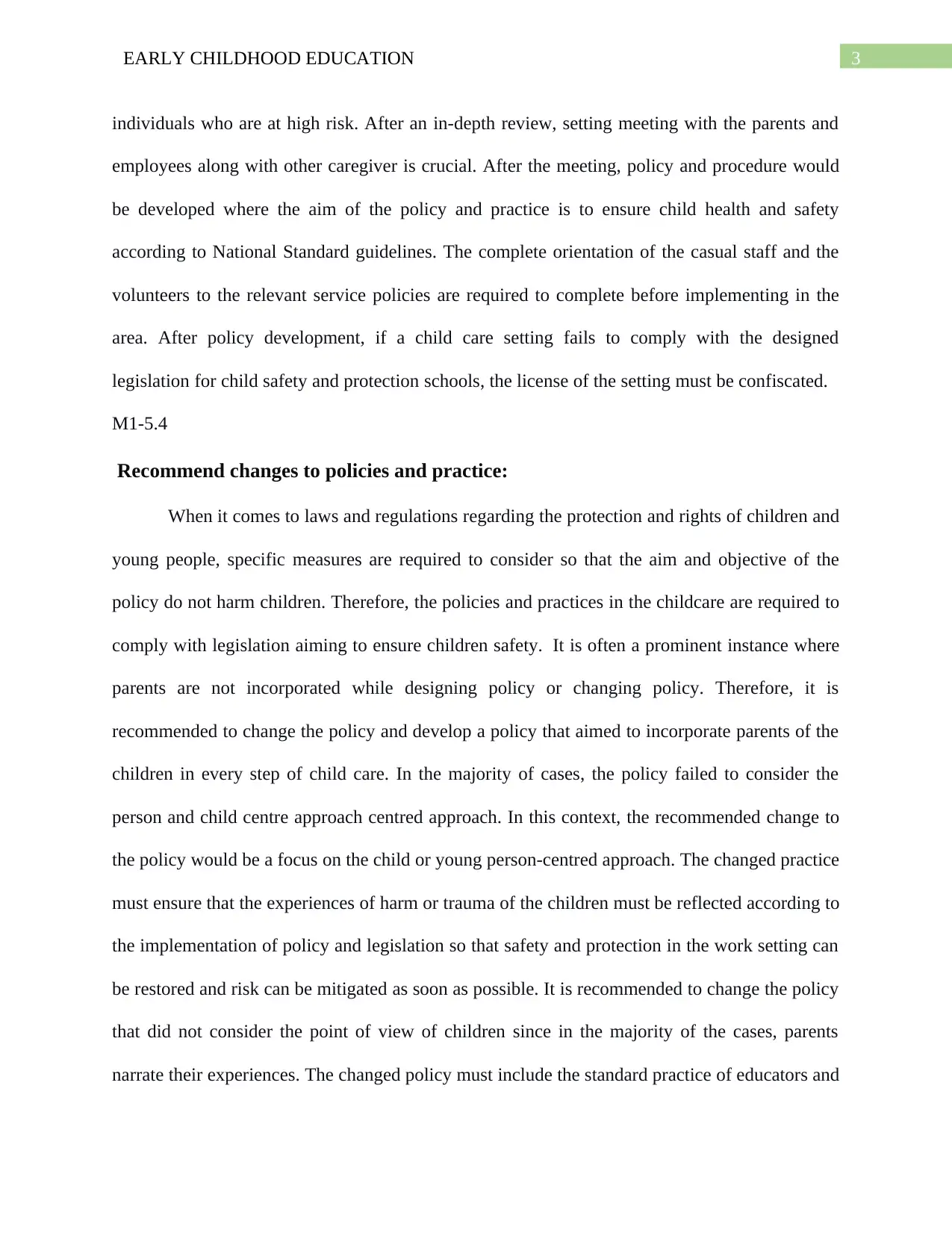
3EARLY CHILDHOOD EDUCATION
individuals who are at high risk. After an in-depth review, setting meeting with the parents and
employees along with other caregiver is crucial. After the meeting, policy and procedure would
be developed where the aim of the policy and practice is to ensure child health and safety
according to National Standard guidelines. The complete orientation of the casual staff and the
volunteers to the relevant service policies are required to complete before implementing in the
area. After policy development, if a child care setting fails to comply with the designed
legislation for child safety and protection schools, the license of the setting must be confiscated.
M1-5.4
Recommend changes to policies and practice:
When it comes to laws and regulations regarding the protection and rights of children and
young people, specific measures are required to consider so that the aim and objective of the
policy do not harm children. Therefore, the policies and practices in the childcare are required to
comply with legislation aiming to ensure children safety. It is often a prominent instance where
parents are not incorporated while designing policy or changing policy. Therefore, it is
recommended to change the policy and develop a policy that aimed to incorporate parents of the
children in every step of child care. In the majority of cases, the policy failed to consider the
person and child centre approach centred approach. In this context, the recommended change to
the policy would be a focus on the child or young person-centred approach. The changed practice
must ensure that the experiences of harm or trauma of the children must be reflected according to
the implementation of policy and legislation so that safety and protection in the work setting can
be restored and risk can be mitigated as soon as possible. It is recommended to change the policy
that did not consider the point of view of children since in the majority of the cases, parents
narrate their experiences. The changed policy must include the standard practice of educators and
individuals who are at high risk. After an in-depth review, setting meeting with the parents and
employees along with other caregiver is crucial. After the meeting, policy and procedure would
be developed where the aim of the policy and practice is to ensure child health and safety
according to National Standard guidelines. The complete orientation of the casual staff and the
volunteers to the relevant service policies are required to complete before implementing in the
area. After policy development, if a child care setting fails to comply with the designed
legislation for child safety and protection schools, the license of the setting must be confiscated.
M1-5.4
Recommend changes to policies and practice:
When it comes to laws and regulations regarding the protection and rights of children and
young people, specific measures are required to consider so that the aim and objective of the
policy do not harm children. Therefore, the policies and practices in the childcare are required to
comply with legislation aiming to ensure children safety. It is often a prominent instance where
parents are not incorporated while designing policy or changing policy. Therefore, it is
recommended to change the policy and develop a policy that aimed to incorporate parents of the
children in every step of child care. In the majority of cases, the policy failed to consider the
person and child centre approach centred approach. In this context, the recommended change to
the policy would be a focus on the child or young person-centred approach. The changed practice
must ensure that the experiences of harm or trauma of the children must be reflected according to
the implementation of policy and legislation so that safety and protection in the work setting can
be restored and risk can be mitigated as soon as possible. It is recommended to change the policy
that did not consider the point of view of children since in the majority of the cases, parents
narrate their experiences. The changed policy must include the standard practice of educators and
Paraphrase This Document
Need a fresh take? Get an instant paraphrase of this document with our AI Paraphraser

4EARLY CHILDHOOD EDUCATION
staffs that allow children level of comfort and trust in their wish so that they get the opportunity
and the feeling of safety. The changed policy must incorporate resilience approach for the
children who are disabled and are at high risk committing suicide and self-harm. The standard
policy change procedure is to review current policy and procedures and through the review,
outdated or irrelevant methods can be discarded while newer procedures that are helpful in the
implementation of laws are to be adopted. The review must be conducted from impartiality and
neutrality of the judiciary and executed from a clear, legal lens. After the review, the changed
policy would be implemented.
MU54-2.5
Liaise with different organisations as part of the development:
Numerous legislation, policy and procedures are reviewed and updated regularly for
supporting as well as protecting young people and children. In the United Arab Emirates, the
government mandate new employers of companies to request for a Police Clearance Letter from
the employee in order to ensure that they comply with the standard practice of good conduct to
work. The underlying reason behind the police clearance is that it is a criminal offence for the
employee to behave extremely harshly with children and young people, neglecting their needs
according to the ‘Protection of Children’s Act 1999’ and the ‘Criminal Justice and Court Service
Act 2000. Similarly in the United Kingdom, various companies are required to complete the
CRB process as according to the national policy no unsuitable people can work with vulnerable
groups. For safeguarding the basic rights of the individuals especially children and young
population, a DBS check is conducted before starting employment of each employee. The policy
of DBS contains specific safeguarding rules such as Swansea Western Bay LSB and the All
Wales Child Protection legislation and procedure so that minors can be protected from all forms
staffs that allow children level of comfort and trust in their wish so that they get the opportunity
and the feeling of safety. The changed policy must incorporate resilience approach for the
children who are disabled and are at high risk committing suicide and self-harm. The standard
policy change procedure is to review current policy and procedures and through the review,
outdated or irrelevant methods can be discarded while newer procedures that are helpful in the
implementation of laws are to be adopted. The review must be conducted from impartiality and
neutrality of the judiciary and executed from a clear, legal lens. After the review, the changed
policy would be implemented.
MU54-2.5
Liaise with different organisations as part of the development:
Numerous legislation, policy and procedures are reviewed and updated regularly for
supporting as well as protecting young people and children. In the United Arab Emirates, the
government mandate new employers of companies to request for a Police Clearance Letter from
the employee in order to ensure that they comply with the standard practice of good conduct to
work. The underlying reason behind the police clearance is that it is a criminal offence for the
employee to behave extremely harshly with children and young people, neglecting their needs
according to the ‘Protection of Children’s Act 1999’ and the ‘Criminal Justice and Court Service
Act 2000. Similarly in the United Kingdom, various companies are required to complete the
CRB process as according to the national policy no unsuitable people can work with vulnerable
groups. For safeguarding the basic rights of the individuals especially children and young
population, a DBS check is conducted before starting employment of each employee. The policy
of DBS contains specific safeguarding rules such as Swansea Western Bay LSB and the All
Wales Child Protection legislation and procedure so that minors can be protected from all forms
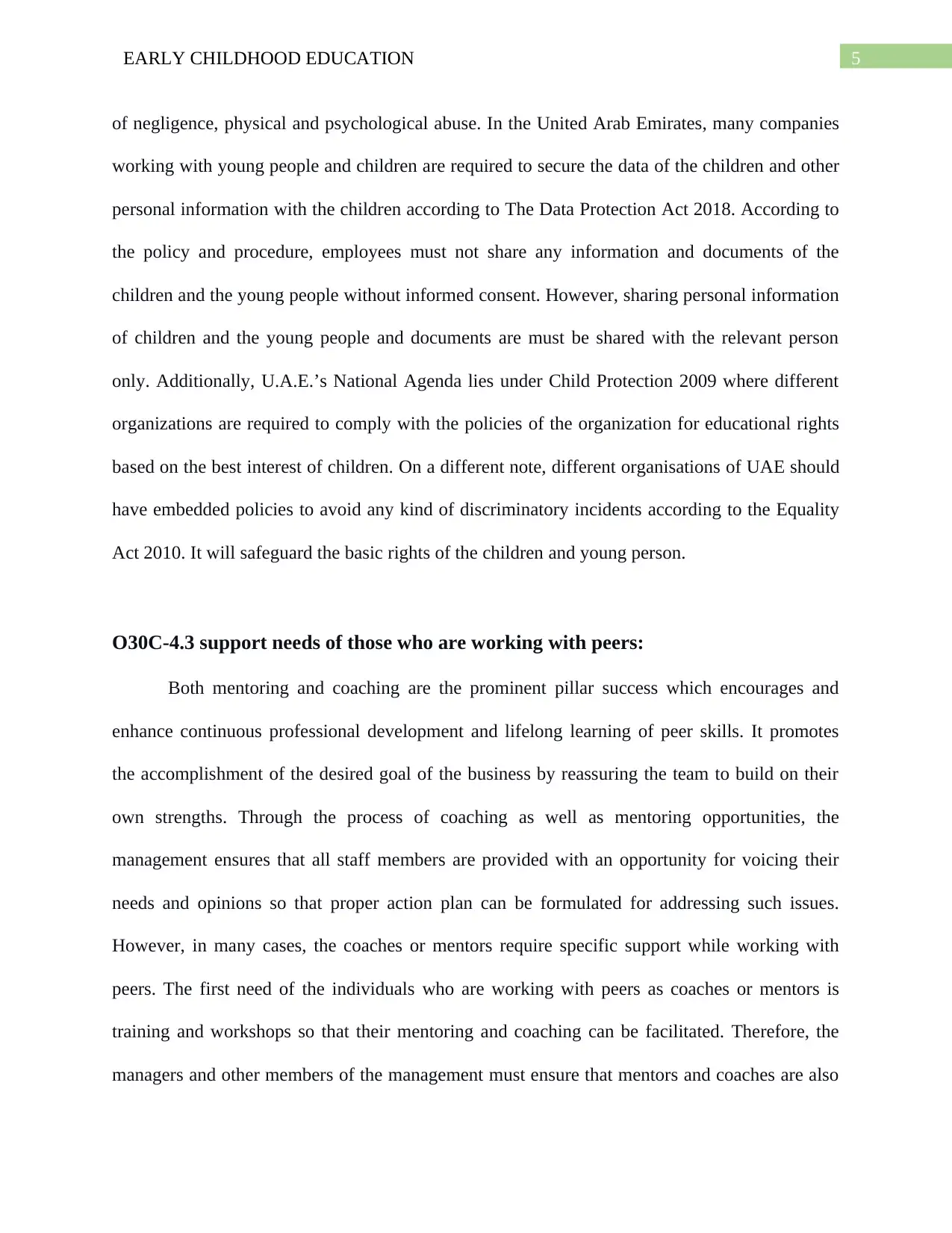
5EARLY CHILDHOOD EDUCATION
of negligence, physical and psychological abuse. In the United Arab Emirates, many companies
working with young people and children are required to secure the data of the children and other
personal information with the children according to The Data Protection Act 2018. According to
the policy and procedure, employees must not share any information and documents of the
children and the young people without informed consent. However, sharing personal information
of children and the young people and documents are must be shared with the relevant person
only. Additionally, U.A.E.’s National Agenda lies under Child Protection 2009 where different
organizations are required to comply with the policies of the organization for educational rights
based on the best interest of children. On a different note, different organisations of UAE should
have embedded policies to avoid any kind of discriminatory incidents according to the Equality
Act 2010. It will safeguard the basic rights of the children and young person.
O30C-4.3 support needs of those who are working with peers:
Both mentoring and coaching are the prominent pillar success which encourages and
enhance continuous professional development and lifelong learning of peer skills. It promotes
the accomplishment of the desired goal of the business by reassuring the team to build on their
own strengths. Through the process of coaching as well as mentoring opportunities, the
management ensures that all staff members are provided with an opportunity for voicing their
needs and opinions so that proper action plan can be formulated for addressing such issues.
However, in many cases, the coaches or mentors require specific support while working with
peers. The first need of the individuals who are working with peers as coaches or mentors is
training and workshops so that their mentoring and coaching can be facilitated. Therefore, the
managers and other members of the management must ensure that mentors and coaches are also
of negligence, physical and psychological abuse. In the United Arab Emirates, many companies
working with young people and children are required to secure the data of the children and other
personal information with the children according to The Data Protection Act 2018. According to
the policy and procedure, employees must not share any information and documents of the
children and the young people without informed consent. However, sharing personal information
of children and the young people and documents are must be shared with the relevant person
only. Additionally, U.A.E.’s National Agenda lies under Child Protection 2009 where different
organizations are required to comply with the policies of the organization for educational rights
based on the best interest of children. On a different note, different organisations of UAE should
have embedded policies to avoid any kind of discriminatory incidents according to the Equality
Act 2010. It will safeguard the basic rights of the children and young person.
O30C-4.3 support needs of those who are working with peers:
Both mentoring and coaching are the prominent pillar success which encourages and
enhance continuous professional development and lifelong learning of peer skills. It promotes
the accomplishment of the desired goal of the business by reassuring the team to build on their
own strengths. Through the process of coaching as well as mentoring opportunities, the
management ensures that all staff members are provided with an opportunity for voicing their
needs and opinions so that proper action plan can be formulated for addressing such issues.
However, in many cases, the coaches or mentors require specific support while working with
peers. The first need of the individuals who are working with peers as coaches or mentors is
training and workshops so that their mentoring and coaching can be facilitated. Therefore, the
managers and other members of the management must ensure that mentors and coaches are also
⊘ This is a preview!⊘
Do you want full access?
Subscribe today to unlock all pages.

Trusted by 1+ million students worldwide
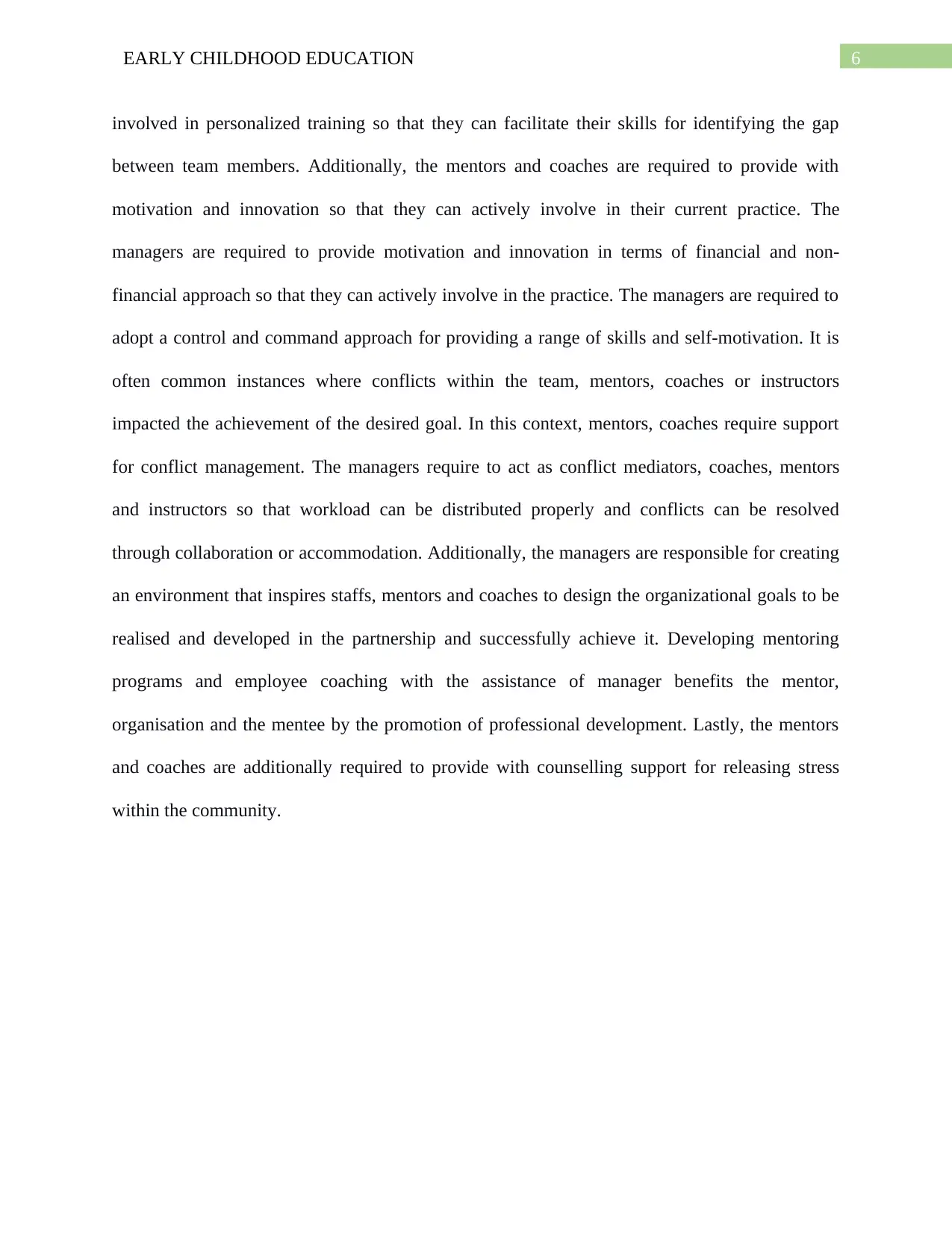
6EARLY CHILDHOOD EDUCATION
involved in personalized training so that they can facilitate their skills for identifying the gap
between team members. Additionally, the mentors and coaches are required to provide with
motivation and innovation so that they can actively involve in their current practice. The
managers are required to provide motivation and innovation in terms of financial and non-
financial approach so that they can actively involve in the practice. The managers are required to
adopt a control and command approach for providing a range of skills and self-motivation. It is
often common instances where conflicts within the team, mentors, coaches or instructors
impacted the achievement of the desired goal. In this context, mentors, coaches require support
for conflict management. The managers require to act as conflict mediators, coaches, mentors
and instructors so that workload can be distributed properly and conflicts can be resolved
through collaboration or accommodation. Additionally, the managers are responsible for creating
an environment that inspires staffs, mentors and coaches to design the organizational goals to be
realised and developed in the partnership and successfully achieve it. Developing mentoring
programs and employee coaching with the assistance of manager benefits the mentor,
organisation and the mentee by the promotion of professional development. Lastly, the mentors
and coaches are additionally required to provide with counselling support for releasing stress
within the community.
involved in personalized training so that they can facilitate their skills for identifying the gap
between team members. Additionally, the mentors and coaches are required to provide with
motivation and innovation so that they can actively involve in their current practice. The
managers are required to provide motivation and innovation in terms of financial and non-
financial approach so that they can actively involve in the practice. The managers are required to
adopt a control and command approach for providing a range of skills and self-motivation. It is
often common instances where conflicts within the team, mentors, coaches or instructors
impacted the achievement of the desired goal. In this context, mentors, coaches require support
for conflict management. The managers require to act as conflict mediators, coaches, mentors
and instructors so that workload can be distributed properly and conflicts can be resolved
through collaboration or accommodation. Additionally, the managers are responsible for creating
an environment that inspires staffs, mentors and coaches to design the organizational goals to be
realised and developed in the partnership and successfully achieve it. Developing mentoring
programs and employee coaching with the assistance of manager benefits the mentor,
organisation and the mentee by the promotion of professional development. Lastly, the mentors
and coaches are additionally required to provide with counselling support for releasing stress
within the community.
Paraphrase This Document
Need a fresh take? Get an instant paraphrase of this document with our AI Paraphraser

7EARLY CHILDHOOD EDUCATION
Bibliography:
Al Gharaibeh, F. and Gibson, L., 2019. Care and rehabilitation services to child victims of abuse
in the United Arab Emirates: Examples of innovation. Children and Youth Services Review, 101,
pp.87-98.
Al Gharaibeh, F. and Gibson, L., 2019. Care and rehabilitation services to child victims of abuse
in the United Arab Emirates: Examples of innovation. Children and Youth Services Review, 101,
pp.87-98.
Bakken, L., Brown, N. and Downing, B., 2017. Early childhood education: The long-term
benefits. Journal of research in Childhood Education, 31(2), pp.255-269.
Osaili, T.M., Attlee, A., Naveed, H., Maklai, H., Mahmoud, M., Hamadeh, N., Asif, T., Hasan,
H. and Obaid, R.S., 2019. Physical Status and Parent-Child Feeding Behaviours in Children and
Adolescents with Down Syndrome in The United Arab Emirates. International journal of
environmental research and public health, 16(13), p.2264.
Sabban, R., 2019. In/Dependence of the Local and Dependence of the Foreign: The Uae Family,
Domestic Service, and a Precarious Future. In Asian Migrant Workers in the Arab Gulf
States (pp. 103-124). Brill.
Song, Y. and Dong, X.Y., 2018. Childcare costs and migrant and local mothers' labor force
participation in urban China. Feminist Economics, 24(2), pp.122-146.
Takriti, R.A., Elhoweris, H. and Atkinson, S.J., 2020. Examining the expectations of early years’
teachers in the UAE regarding a successful start to school for children with and without special
educational needs. Early Child Development and Care, 190(4), pp.516-525.
Bibliography:
Al Gharaibeh, F. and Gibson, L., 2019. Care and rehabilitation services to child victims of abuse
in the United Arab Emirates: Examples of innovation. Children and Youth Services Review, 101,
pp.87-98.
Al Gharaibeh, F. and Gibson, L., 2019. Care and rehabilitation services to child victims of abuse
in the United Arab Emirates: Examples of innovation. Children and Youth Services Review, 101,
pp.87-98.
Bakken, L., Brown, N. and Downing, B., 2017. Early childhood education: The long-term
benefits. Journal of research in Childhood Education, 31(2), pp.255-269.
Osaili, T.M., Attlee, A., Naveed, H., Maklai, H., Mahmoud, M., Hamadeh, N., Asif, T., Hasan,
H. and Obaid, R.S., 2019. Physical Status and Parent-Child Feeding Behaviours in Children and
Adolescents with Down Syndrome in The United Arab Emirates. International journal of
environmental research and public health, 16(13), p.2264.
Sabban, R., 2019. In/Dependence of the Local and Dependence of the Foreign: The Uae Family,
Domestic Service, and a Precarious Future. In Asian Migrant Workers in the Arab Gulf
States (pp. 103-124). Brill.
Song, Y. and Dong, X.Y., 2018. Childcare costs and migrant and local mothers' labor force
participation in urban China. Feminist Economics, 24(2), pp.122-146.
Takriti, R.A., Elhoweris, H. and Atkinson, S.J., 2020. Examining the expectations of early years’
teachers in the UAE regarding a successful start to school for children with and without special
educational needs. Early Child Development and Care, 190(4), pp.516-525.
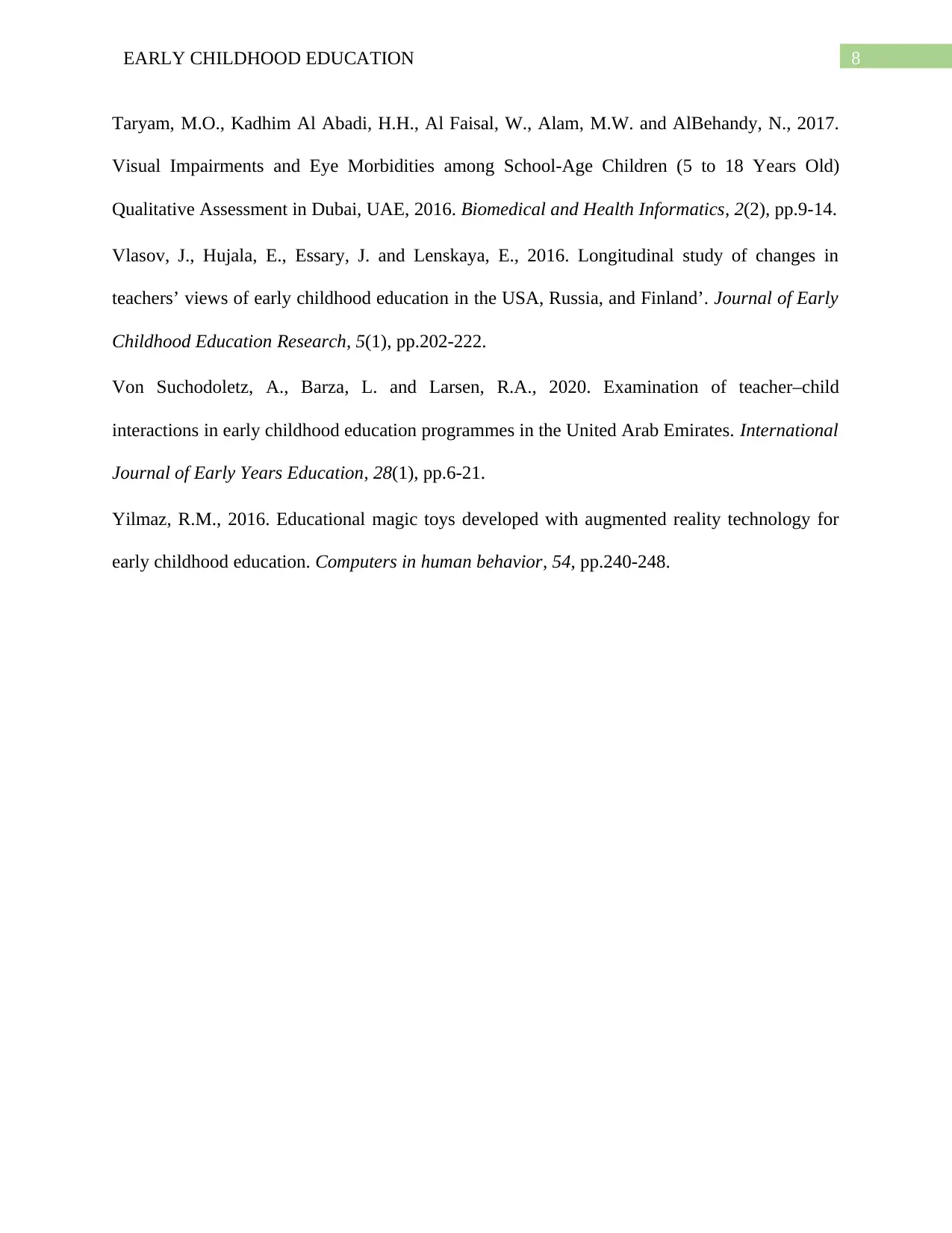
8EARLY CHILDHOOD EDUCATION
Taryam, M.O., Kadhim Al Abadi, H.H., Al Faisal, W., Alam, M.W. and AlBehandy, N., 2017.
Visual Impairments and Eye Morbidities among School-Age Children (5 to 18 Years Old)
Qualitative Assessment in Dubai, UAE, 2016. Biomedical and Health Informatics, 2(2), pp.9-14.
Vlasov, J., Hujala, E., Essary, J. and Lenskaya, E., 2016. Longitudinal study of changes in
teachers’ views of early childhood education in the USA, Russia, and Finland’. Journal of Early
Childhood Education Research, 5(1), pp.202-222.
Von Suchodoletz, A., Barza, L. and Larsen, R.A., 2020. Examination of teacher–child
interactions in early childhood education programmes in the United Arab Emirates. International
Journal of Early Years Education, 28(1), pp.6-21.
Yilmaz, R.M., 2016. Educational magic toys developed with augmented reality technology for
early childhood education. Computers in human behavior, 54, pp.240-248.
Taryam, M.O., Kadhim Al Abadi, H.H., Al Faisal, W., Alam, M.W. and AlBehandy, N., 2017.
Visual Impairments and Eye Morbidities among School-Age Children (5 to 18 Years Old)
Qualitative Assessment in Dubai, UAE, 2016. Biomedical and Health Informatics, 2(2), pp.9-14.
Vlasov, J., Hujala, E., Essary, J. and Lenskaya, E., 2016. Longitudinal study of changes in
teachers’ views of early childhood education in the USA, Russia, and Finland’. Journal of Early
Childhood Education Research, 5(1), pp.202-222.
Von Suchodoletz, A., Barza, L. and Larsen, R.A., 2020. Examination of teacher–child
interactions in early childhood education programmes in the United Arab Emirates. International
Journal of Early Years Education, 28(1), pp.6-21.
Yilmaz, R.M., 2016. Educational magic toys developed with augmented reality technology for
early childhood education. Computers in human behavior, 54, pp.240-248.
⊘ This is a preview!⊘
Do you want full access?
Subscribe today to unlock all pages.

Trusted by 1+ million students worldwide
1 out of 9
Related Documents
Your All-in-One AI-Powered Toolkit for Academic Success.
+13062052269
info@desklib.com
Available 24*7 on WhatsApp / Email
![[object Object]](/_next/static/media/star-bottom.7253800d.svg)
Unlock your academic potential
Copyright © 2020–2025 A2Z Services. All Rights Reserved. Developed and managed by ZUCOL.




